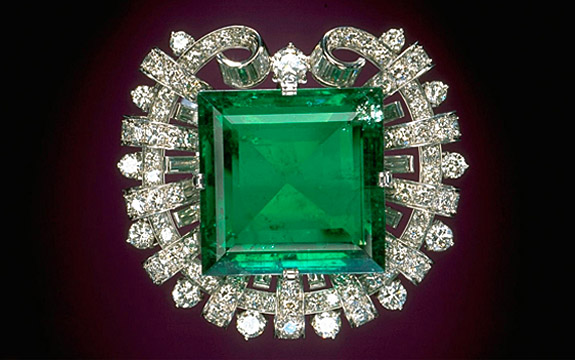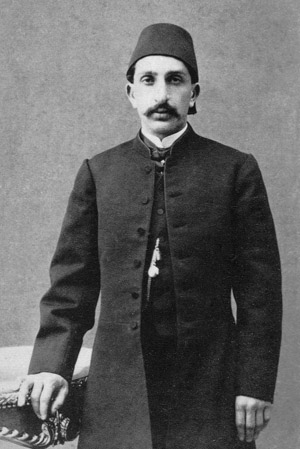May 5th, 2016
One of the world's most spectacular examples of May's official birthstone is the 75.47-carat Hooker Emerald, an historic gem that was once mounted into the belt buckle of an Ottoman sultan.

Today, it is beautifully displayed in a platinum brooch adorned with 109 brilliant-cut diamonds weighing approximately 13 carats. When Janet Annenberg Hooker donated the piece in 1977 to the Smithsonian in Washington, D.C., it was valued at $500,000. Based on inflation alone, today it would be worth $2.03 million.
If the name Janet Annenberg Hooker sounds a bit familiar, it may be because the renowned philanthropist and publishing heiress was the principal benefactor of the Smithsonian's National Museum of Natural History. Her cash donation to the museum of $5 million allowed for the construction of a fabulous gallery, which was named the Janet Annenberg Hooker Hall of Geology, Gems and Minerals.
The emerald brooch designed by Tiffany & Co. is an open-ended circular band of platinum. The two ends of the band curl outward into scrolls and are connected by a large round brilliant-cut diamond. Spokes cross the band and converge in the center, forming the setting for the Hooker Emerald.

The emerald was mined in Colombia in the 16th or 17th century and was sent to Europe by Spanish conquistadors to be cut and polished. The gem was sold to the ruling family of the Ottoman Empire and became part of the crown jewels during the reign of Sultan Abdul Hamid II (1876-1909). The sultan reportedly wore the emerald mounted into his belt buckle.
In 1908, the emerald was smuggled to Paris on behalf of the sultan, who hoped the proceeds from its sale would ensure him a comfortable life in exile should he be dethroned by a revolution. The sultan never received the anticipated windfall. The money raised by the sale of the gem went to the succeeding government.
The massive emerald had been auctioned to Tiffany & Co, which initially set it in a tiara. Despite its beauty, the tiara remained unsold for decades. In 1950, the emerald was re-set into a brooch that included matching earrings. Five years later, the brooch was purchased by Hooker. In 1977, she donated it to the Smithsonian.
The Hall of Geology, Gems and Minerals that was named in her honor was officially opened in September of 1997, just three months before she passed away at the age of 93.
Lush green emeralds have excited legions of gem admirers for thousands of years. The first emerald mines were in Egypt, and Cleopatra was known to favor this, the most famous member of the beryl family. The name "emerald" comes indirectly from the ancient Greek word for green, “smaragdos.” Ancient Romans believed emerald could relieve eyestrain, and the grass-green emerald was said to be one of the four precious stones given by God to King Solomon.
Besides being the birthstone for the month of May, it's also the official gemstone for 20th and 35th wedding anniversaries.
Credit: Hooker Emerald by Chip Clark, courtesy Smithsonian Institution, National Museum of Natural History; Sultan Abdul Hamid II (public domain).

Today, it is beautifully displayed in a platinum brooch adorned with 109 brilliant-cut diamonds weighing approximately 13 carats. When Janet Annenberg Hooker donated the piece in 1977 to the Smithsonian in Washington, D.C., it was valued at $500,000. Based on inflation alone, today it would be worth $2.03 million.
If the name Janet Annenberg Hooker sounds a bit familiar, it may be because the renowned philanthropist and publishing heiress was the principal benefactor of the Smithsonian's National Museum of Natural History. Her cash donation to the museum of $5 million allowed for the construction of a fabulous gallery, which was named the Janet Annenberg Hooker Hall of Geology, Gems and Minerals.
The emerald brooch designed by Tiffany & Co. is an open-ended circular band of platinum. The two ends of the band curl outward into scrolls and are connected by a large round brilliant-cut diamond. Spokes cross the band and converge in the center, forming the setting for the Hooker Emerald.

The emerald was mined in Colombia in the 16th or 17th century and was sent to Europe by Spanish conquistadors to be cut and polished. The gem was sold to the ruling family of the Ottoman Empire and became part of the crown jewels during the reign of Sultan Abdul Hamid II (1876-1909). The sultan reportedly wore the emerald mounted into his belt buckle.
In 1908, the emerald was smuggled to Paris on behalf of the sultan, who hoped the proceeds from its sale would ensure him a comfortable life in exile should he be dethroned by a revolution. The sultan never received the anticipated windfall. The money raised by the sale of the gem went to the succeeding government.
The massive emerald had been auctioned to Tiffany & Co, which initially set it in a tiara. Despite its beauty, the tiara remained unsold for decades. In 1950, the emerald was re-set into a brooch that included matching earrings. Five years later, the brooch was purchased by Hooker. In 1977, she donated it to the Smithsonian.
The Hall of Geology, Gems and Minerals that was named in her honor was officially opened in September of 1997, just three months before she passed away at the age of 93.
Lush green emeralds have excited legions of gem admirers for thousands of years. The first emerald mines were in Egypt, and Cleopatra was known to favor this, the most famous member of the beryl family. The name "emerald" comes indirectly from the ancient Greek word for green, “smaragdos.” Ancient Romans believed emerald could relieve eyestrain, and the grass-green emerald was said to be one of the four precious stones given by God to King Solomon.
Besides being the birthstone for the month of May, it's also the official gemstone for 20th and 35th wedding anniversaries.
Credit: Hooker Emerald by Chip Clark, courtesy Smithsonian Institution, National Museum of Natural History; Sultan Abdul Hamid II (public domain).


